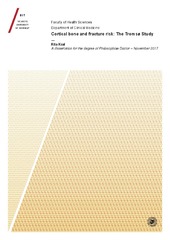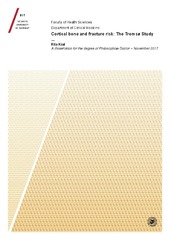| dc.contributor.advisor | Bjørnerem, Åshild | |
| dc.contributor.author | Kral, Rita | |
| dc.date.accessioned | 2018-10-17T11:01:24Z | |
| dc.date.available | 2018-10-17T11:01:24Z | |
| dc.date.issued | 2018-03-20 | |
| dc.description.abstract | Background: The aim of this thesis was to explore the association of the cortical architecture of the proximal femoral shaft with non-vertebral fractures. We tested the hypotheses that: (i) cortical parameters are associated with fracture risk independent of Fracture Risk Assessment Tool (FRAX) or Garvan estimates, (ii) women with fractures that are unidentified by FRAX but identified by cortical porosity have a different patient profile that contributes to their fracture risk, and (iii) women with type-2 diabetes mellitus (T2DM) have lower bone turnover markers (BTMs) and lower cortical porosity than those without diabetes, and that higher serum glucose level and body mass index (BMI) are associated with lower BTMs and cortical porosity.
Methods: We quantified FRAX and Garvan estimates with femoral neck areal bone mineral density (FN aBMD) and femoral subtrochanteric architecture in 211 postmenopausal women, aged 54–94 years, with non-vertebral fractures and 232 controls in a nested case-control study.
Results: Paper I: Cortical porosity and thickness were associated with fracture risk independent of FRAX and Garvan estimates. Cortical porosity but not cortical thickness improved the net reclassification of fracture cases compared with FRAX alone but not compared with Garvan.
Paper II: Fracture cases unidentified by FRAX but identified by cortical porosity had a patient profile different from fracture cases identified by FRAX. These patients were younger, had a higher FN aBMD, a lower FRAX score, and fewer had a prior fracture, they had higher cortical porosity, thinner cortices, and a larger total bone size than those identified by FRAX alone.
Paper III: Women with T2DM had a higher serum glucose, BMI, and subtrochanteric total volumetric BMD but a lower cortical porosity than nondiabetic women. Increasing serum glucose level was associated with lower BTMs and cortical porosity. Increasing BMI was associated with lower BTMs and thicker cortices.
Conclusion: These results suggest that cortical porosity was the most important cortical parameter associated with fracture risk. Fracture cases unidentified by high FRAX score but identified by high cortical porosity alone had a different patient profile compared with those identified by FRAX alone. Women with T2DM had lower serum levels of bone turnover markers and a lower cortical porosity than did women without diabetes. Further research is needed in larger prospective studies to determine whether cortical porosity predicts fractures independent of FRAX and can be useful in clinical practice and to examine the reasons why T2DM patients have increased risks for fracture. | en_US |
| dc.description.doctoraltype | ph.d. | en_US |
| dc.description.sponsorship | I want to thank Helse Nord for believing in me and for giving me the financial support to finish this work.
The publication charges for Paper I have been funded by a grant from the publication fund fund of UiT The Arctic University of Norway. | en_US |
| dc.identifier.uri | https://hdl.handle.net/10037/13979 | |
| dc.language.iso | eng | en_US |
| dc.publisher | UiT The Arctic University of Norway | en_US |
| dc.publisher | UiT Norges arktiske universitet | en_US |
| dc.relation.haspart | <p>Paper I: Kral, R., Osima, M., Borgen, T. T., Vestgaard, R., Richardsen, E., Bjørnerem, Å. (2017). Increased cortical porosity and reduced cortical thickness of the proximal femur are associated with nonvertebral fracture independent of Fracture Risk Assessment Tool and Garvan estimates in postmenopausal women. <i>PLoS ONE</i> 12(9):e0185363. The article is available at <a href=http://hdl.handle.net/10037/11902>http://hdl.handle.net/10037/11902. </a></p>
<p>Paper II: Kral, R., Osima, M., Vestgaard, R., Richardsen, E., Bjørnerem, Å. Women with fracture, unidentified by FRAX, but identified by cortical porosity, have a different patient profile that contribute to fracture risk. (Manuscript). Published version with altered title is available in <i>Bone</i>, 116 (2018) 259-265: <a href=https://doi.org/10.1016/j.bone.2018.08.018>https://doi.org/10.1016/j.bone.2018.08.018.</a></p>
<p>Paper III: Osima, M., Kral, R., Borgen, T. T., Høgestøl, I. K., Joakimsen, R. M., Eriksen, E. F., Bjørnerem, Å. (2017). Women with type 2 diabetes mellitus have lower cortical porosity of the proximal femoral shaft using low-resolution CT than nondiabetic women, and increasing glucose is associated with reduced cortical porosity. <i>Bone</i>, 97, 252-260. Also available in <a href=https://doi.org/10.1016/j.bone.2017.01.037> https://doi.org/10.1016/j.bone.2017.01.037. </a></p> | en_US |
| dc.rights.accessRights | openAccess | en_US |
| dc.rights.holder | Copyright 2018 The Author(s) | |
| dc.rights.uri | https://creativecommons.org/licenses/by-nc-sa/3.0 | en_US |
| dc.rights | Attribution-NonCommercial-ShareAlike 3.0 Unported (CC BY-NC-SA 3.0) | en_US |
| dc.subject | VDP::Medisinske Fag: 700::Helsefag: 800 | en_US |
| dc.subject | VDP::Medical disciplines: 700::Health sciences: 800 | en_US |
| dc.subject | The Tromsø Study | |
| dc.subject | Tromsøundersøkelsen | |
| dc.title | Cortical bone and fracture risk: The Tromsø Study | en_US |
| dc.type | Doctoral thesis | en_US |
| dc.type | Doktorgradsavhandling | en_US |


 English
English norsk
norsk




